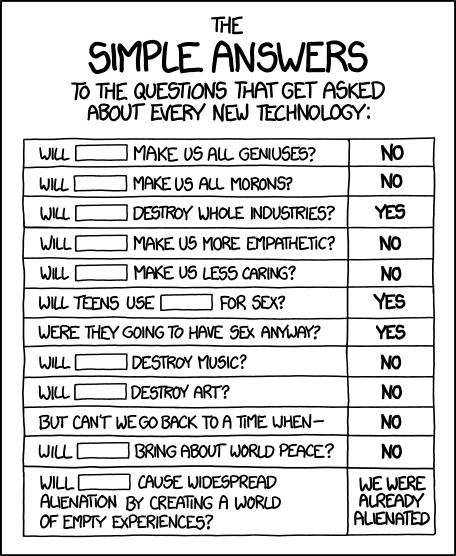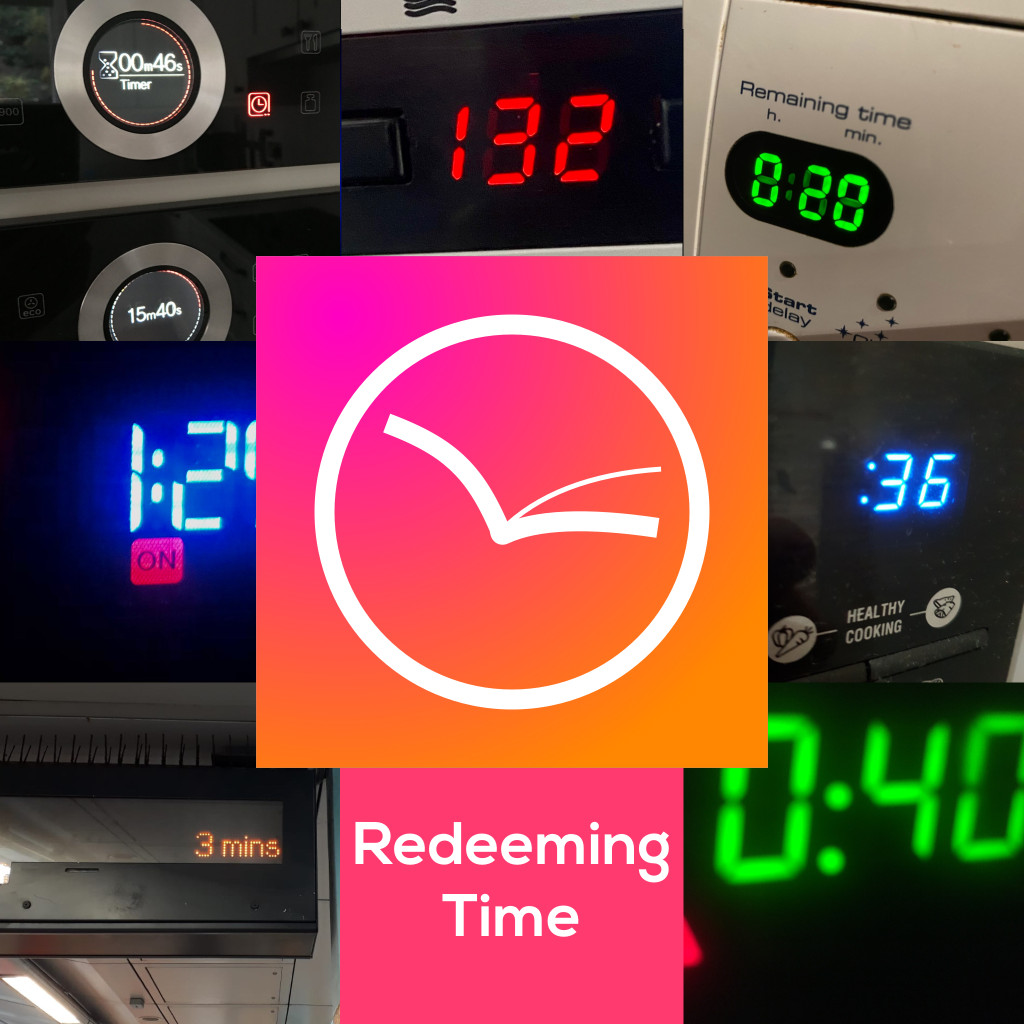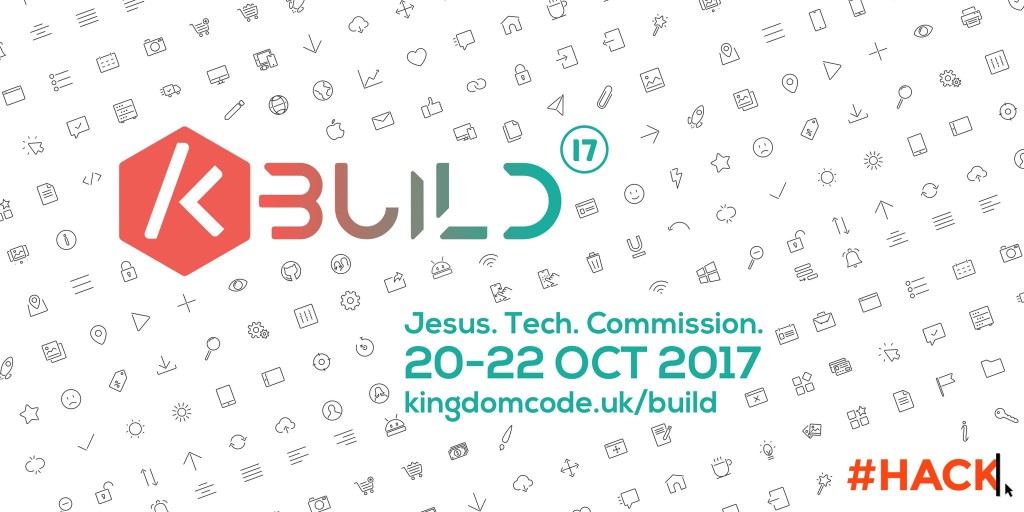Update: This is really old and there’s a more recent follow-up post that goes with it
The other weekend I went to speak at a men’s breakfast at St. Luke’s Wimbledon Park on the topic of “how should Christians engage with technology?” It’s something I’ve been wanting to put together a talk on ever since my time studying on the Cornhill Training Course and working as their IT guy, a period of my life which gave me plenty of time to think about how theology and technology interact (this was also when I first developed the PrayerMate app).
I think this is a topic which Christians ought to be encouraged to think about a lot more than we do, because it’s something that’s both really important and all too easy not to think about all that hard. For that reason, here are my notes from my talk.
The fact is that technology is absolutely everywhere. Even if you think you’re a luddite who’s hopeless with technology, there’s a chance that you own a pair of glasses – well, that’s technology. There’s a very good chance that you use electric lighting to stay up beyond sundown – that’s certainly technology. Even if you go to bed at 5pm in the winter, you’re certain to have read a book or two in your lifetime (though frankly, if you’re going to bed at 5pm, I don’t know where you find the time!) The humble book employs an enormous amount of technology – from the paper it’s printed on, to the printing press used to copy it (perhaps one of the most revolutionary pieces of technology ever invented), to the alphabet itself, which believe it or not hasn’t always existed and once upon a time somebody sat down and invented.
“Technology” is basically anything that is created by human beings to help us reach beyond what we would be able to do without it – whether that’s just doing an old thing more efficiently, or whether it’s doing something that was entirely impossible before. Technology is all around us, and it’s so deeply woven into the very fabric of our lives that we barely even notice it’s there. That’s precisely why it’s so important that we do take time out to consider it from a Christian perspective – because the technology we use always changes us.
There’s masses and masses I could say on the topic, but I’m going to basically address three areas: technology is not morally neutral; technology changes how we think; and some practical thoughts on using technology.
Technology is not morally neutral
When it comes to technology, it’s very easy to respond in one of two ways:
- There’s the approach that just rejects all new technology outright – we don’t like the change it represents, so we reject it en masse as evil. It took me years and years before I got my first mobile phone, and in the mean time I stubbornly rejected it.
- The other common response is that we embrace it wholeheartedly as an unambiguously positive force for good. The culture around us often portrays all technological progress as a step forwards – newer is always better, and just because something can be done, then that something should be done.
But if we look at what the Bible has to say, then I think we can say that both of these approaches are lacking. Have a look at Genesis 1:27-27:
“So God created mankind in his own image, in the image of God he created them; male and female he created them. God blessed them and said to them, ‘Be fruitful and increase in number; fill the earth and subdue it. Rule over the fish of the sea and the birds in the sky and over every living creature that moves on the ground.'”
So we see that God is a creator – he makes things. And one of the pinnacles of his creation is that he creates men and women, and he creates us in his image, so that we too will be creators who in turn like to make things. As we master the world around us and bring our ingenuity to bear on the problems that we face, we’re actually reflecting something of the image of God, and that’s a good thing and a right thing. It’s part of how we’re going to fulfill that creation mandate that God gave to Adam and Eve, to “fill the earth and subdue it” and rule over it.
So our ability to create technology is a good and a positive thing that reflects something of the image of God. But we also need to recognise that we live the other side of Genesis 3: in Genesis 3 we see humanity rejecting God’s good purpose for our lives, and in judgement God puts a curse on his creation.
“Cursed is the ground because of you; through painful toil you will eat food from it all the days of your life” (Genesis 3:17)
So things are now distorted and warped. The creation order is turned upside down, the things we created to help us master the creation now try to master us. It’s a few chapters later that we get the first clear example of technology in the Bible, in the hands of one of the murderer Cain’s descendants, “who forged all kinds of tools out of bronze and iron” – it’s not loads clear, so don’t attach too much weight to it, but it’s not presented as entirely positive. Then you get the first major building project in the history of humanity in the form of the Tower of Babel, which again is not exactly portrayed in an overwhelmingly positive light. There it’s an example of technology being used to exert independence from God – making a name for ourselves apart from our relationship to God.
So the basic principle which we need to establish when thinking about technology is this: technology by itself is what we might call “amoral” – that is, it is neither overwhelmingly good nor inherently evil. Like lots of things in this world it’s something with great power for good but which is also deeply affected by the fall. What’s important is how we use that technology – what we use it to do, and what we allow it to do to us.
Technology is neither overwhelmingly good nor inherently evil – it’s how we USE it that counts.
Some of the benefits of technology are easy to spot – maybe it’s an app like PrayerMate that can help you in your prayer life, maybe it’s a Facebook message to a struggling friend that gives them the encouragement they need to keep going, maybe it’s just the way that electric lighting and central heating helps our midweek Bible studies go better, or the way that the printing press has enabled the Bible to be distributed far and wide and put into the hands of ordinary people. Technology has enabled some wonderful things.
But technology can also very easily become an idol in our lives. Most of what I have to say here is really inspired by Tim Challies’ book “The Next Story” (which you should all go out and read immediately), and he says this:
“Though the devices and tools we create are inherently amoral, at the same time we would be foolish to believe that they are morally neutral. The things we create to assist us in overcoming the consequences of the curse also seek to dominate us, drawing our hearts away from God rather than drawing us toward him in dependence and faith.”
Anything created has the potential to become an idol in our lives – something that we put our trust in instead of God. And technology has perhaps a greater-than-average risk of being turned into an idol because it is so powerful in extending our abilities and what we’re able to achieve – it promises to help make us a little more like God, and overcome our finiteness and weakness. And that’s something we need to be aware of and pray against. It can be that the technology is an idol in itself (the latest iDols from Apple, perhaps?) or they can enable other idols, such as my pride, as I project an image of living the most remarkable life imaginable on Facebook, or lust, in the form of Internet pornography and so on.
My goal here is to encourage us all just to be a little more thinking in our attitude to technology – not to reject it outright, nor to embrace it unquestioningly. Instead, to try to see beyond the superficial and to think a bit more about how it affects us, and why we feel about it the way we do.
Technology changes how we think
It’s really important to recognise that our technology has the power to radically alter how we perceive and think about the world around us. If you’ve ever read Neil Postman’s book “Amusing Ourselves to Death“, he argues that the advent of television completely revolutionised how we engaged with everything from politics to education (had the internet been invented at the time he was writing, I’m sure he’d have said his hypothesis was even more true of that). Because of the television, we’ve become a very visual culture. Postman talks about how important it is these days for politicians to look the part if they’re to get elected, because so much is decided by the public watching them on telly. He asks how many of the great leaders of the past would still have been elected if they were to run for office today?
So, technology can change how we think. How many of you have ever made a decision about what to wear or what to do, because you’ve been thinking “how will this look on Facebook?” Or maybe that’s just me!
Let’s briefly consider just two examples of ways that technology changes how we think. Even if you don’t think these are relevant to you, they’re sure to be relevant to your children or the people that we’re trying to reach in our churches.
1. Technology means we’ve redefined community
In the old days, your community was defined by your physical geography – where you lived – and primarily that usually meant your family who you shared a house with. So if you wanted to contact somebody, you’d call the family telephone, or you’d write a letter to the family address. Now it’s shifted from our geography to being much more about the individual, and our preferences – so our community can be a virtual one defined by common interests. You email me as an individual, you send me a text message as an individual – and it’s all completely cut off from my geographical context, my family context.
So does that mean I should throw away my mobile phone, close my GMail account and refuse to communicate with anybody except by snail mail? Of course not! Apart from anything else, it’s probably too late for that! But being conscious of the way that our technology has changed us, we can be armed to think about how this might have a knock on effect for our godliness, how we relate to God and to one another. There’s no doubt that this is one of the reasons why as a culture we increasingly find church so hard work these days, because very often we don’t have a whole lot in common with the other people we go to church with, we’re not that bothered about our local community, and it all feels a little bit too much like hard work. We’re going to need to go back to our Bibles to figure out why we should bother with church, and how to persuade the next generation to bother with church in a world where meeting together physically in one place is increasingly less interesting. Communication is increasingly about “mediated” contact these days – it’s much less daunting to send a text message or an email to somebody that they can read at their leisure than it is to look them in the eye and give them my full attention and require their full attention in response. Going to church is such an alien concept in a world of mediated contact!
2. Technology means we’ve redefined truth
I don’t know if you’ve ever tried anything on Wikipedia before – but there are very strict guidelines that determine what you’re allowed to say on Wikipedia. It’s all based around the concept of “consensus” – everything you write has to have a citation from another source, everything has to be backed up by somebody else who agrees with you. They explicitly say that it’s not a place for original ideas or new thinking.
Or if it’s not about consensus, it’s all about “relevance”. As sites like Google and Facebook have to deal with larger and larger volumes of information, they’re getting more and more sophisticated in filtering things out so that they only show you what they think you’ll consider “relevant”. You’ll see more and more content from the friends that it thinks you engage with and less and less content from the friends that it’s decided you’re not really that interested in, and it’s all very self-reinforcing.
Both of these ways of defining the truth – consensus and relevance – have problems for the Christian, because we believe in revelation. Biblical truth often clashes with consensus, and doesn’t necessarily seem all that relevant to an outsider who’s thinking superficially. But it’s the ultimate truth, and it’s supremely relevant because it’s about our eternal future – if only we have the ears to hear.
Obviously there’s loads more we could say on that topic – plenty of further examples of ways in which our technology changes how we think. But in summary: be on your guard! Don’t engage with technology unthinkingly and expect to come away unchanged.
Some practical thoughts on using technology
Really I just want to talk about one thing under this heading, and that’s distraction. Our technology these days increasingly leads to distraction. If we allow it to, our technology can really begin to own us, with all of the beeps and buzzes and notifications that constantly vie for our attention and drag us away from the real interactions with the people right in front of us.
As a result of all this distraction, we’re less and less able to concentrate for long periods of time, we find ourselves less and less able to do something simple like just sitting and reading a book. It can even get to the point where we find ourselves feeling quite anxious and fidgety if we have to sit with our own thoughts and nothing to distract us. It can draw us away from the people we’re face-to-face with, and be a disaster for our working productivity.
Our hearts long for that little beep, so we feel like we need to leave the volume turned up. But the reality is that the world will still go on if our emails go unread for 30 minutes, and we’d be much better off if we just turned the notifications off and instead just checked in every once and a while.
All this can be a real issue for habits of personal devotion like having quiet times where we spend quality time in God’s word and praying. So many times I’ve been trying to read the Bible, only to find myself checking my phone or my iPad because some idea has occurred to me part way through, and before I know it I’ve completely forgotten what I was looking at.
I think if we’re going to be serious about putting God first in our lives, we have to be pretty radical with our technology.
For myself, it’s a real discipline of trying to make sure that my Bible reading is the first thing I do in the morning, rather than checking my email. It just feels to me like it says a lot about my own priorities that I’m more excited to know if anybody around the world has sent me a nugget of novelty in my inbox, than I am to hear from the Creator of the Universe who has some eternal truth to share with me – and trying to make sure I hold off checking my email until I’ve listened to what he has to say just feels like the right thing to try and do. Apart from anything else, often I’ve only got about 3 minutes of peace and quiet before the baby wakes up, and if I use it to check Facebook then the quiet time may never happen!
Coupled with the short attention span, we have less and less need to exercise our memories, as we become more and more reliant on Google to give us the answers. We don’t know how to memorise scripture any more, because we know we can just look it up on Bible Gateway instead. How much the poorer are we for it?
So let me urge you: keep reading your Bibles, keep reading good Christian books, and why not try to memorise the occasional Bible passage?
Questions to ask our technology
I am aware that this was a bit of a whirlwind tour, with lots left out. However, I hope there’s been something there that was vaguely useful, and some fuel for further thought on the subject.
To close, let me leave you with some questions from Tim Challies that we should ask of any technology. You’ve heard of the discipline of talking to yourself – well here’s some ways you can talk to your mobile phone instead:
- Why were you created? This will often give us some useful insight into the likely effects of this technology. For example, the mobile phone was invented to keep businessmen in contact with the office at all times, so it shouldn’t surprise us if one of the effects of a mobile phone is that suddenly we find ourselves connected to the office at all times!
- What is the problem to which you are the solution, and whose problem is it? The problem that a new technology solves isn’t always my problem – it’s possibly just the solution to the manufacturer’s falling annual profit!
- What new problems will you bring?
- What are you doing to my heart?
Or the very timely XKCD version that was published today:

P.S. I’m trying to raise money to bring my PrayerMate app to Android – can you help?
Related:
Update: This post is really old and there’s a more recent follow-up post that goes with it

















